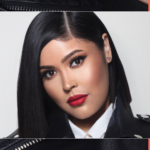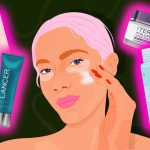Quinn Fitzgerald + Sara de Zárraga
Co-Founders of Flare
-
What They Do

Most of us dream about starting a business—but when it comes with a personal mission, the stakes feel even higher. Enter co-founders Quinn Fitzgerald and Sara de Zárraga, who teamed up to create Flare, a line of personal safety devices by and for women. They developed a piece of wearable tech that's discreetly hidden inside jewelry, so you can use it to silently alert your contacts or the authorities if you find yourself in a scary situation.
“[Most] personal safety devices have been designed by men,” says Sara, “based on what they think women need to keep them safe. We wanted to flip that on its head” by creating an on-trend bracelet that can alert your contacts, or 911, with the discreet press of a button. “We look at safety as an opportunity to reclaim your agency,” Quinn adds. “To take back the power that you inherently have when others aren’t respecting your boundaries or your voice.”
Here’s how the friends and Flare founders balance their personal mission with their love for technology, and why they hope to someday go out of business.
What inspired you to start your brand?
QUINN: Historically, companies have claimed they have the “solution to safety.” That is incredibly damaging and victim-blaming. Sara and I, both survivors of assault and harassment, wanted to offer an effective, practical tool that would give people options to decide what’s right for them in the moment.
SARA: We have a vision to help women live their lives safely, with confidence and control. That’s driven by our own experience, and the experience of thousands of women who tell us their stories. We want to see a cultural shift, changes to our legal system, and better education and resources for those affected by assault, along with better youth education and mental health to help curb toxic masculinity in the first place. But until those systemic changes happen, we wanted to create something that would’ve helped us.
What did you agree needed to be different?
QUINN: In the past, the only tools to protect yourself were a whistle you could blow, pepper or a weapon to harm the other person, or a call for help. And depending on your identity, that help can put you in danger, too. No two situations are the same. So we asked, “How can we use technology to provide women with what they actually need? Options in the moment – to escalate or deescalate – depending on what’s best for you in that situation?”
Can you explain how it works?
SARA: Right now, our bracelets and mobile app offer options to call for help without anyone else knowing. Discretion is key, because sometimes you could be comfortable saying something, but sometimes that would escalate a situation. We offer 3 features: You can send your GPS location via text to friends and family, and let them know you need some backup. You can also send that message to 911, and an operator will call you and send a first responder to your location. The third option is a pre-recorded call that you can use as an excuse to leave. It’s like when you go out on a date and ask your friend to call you to see how it’s going.
How did your different personal styles play into the design?
SARA: I’m wearing our Howlite Beaded Bracelet at the moment. That’s one of my favorites because I wear a lot of black and white. It’s very inconspicuous.
QUINN: My favorite is the Gold Satin Cuff. It goes with every outfit, and it adds a little bit of sparkle in a very subdued way; it gives me some confidence knowing that I can sparkle, too. I know it sounds super cheesy, but I firmly believe in the “embrace your inner weirdness,” and one of mine is that I like sparkles. This is a way of doing it that isn’t really in your face.
What kind of user experience did you imagine for Flare?
SARA: [Flare] is not just people grabbing you in a dark alley, but also helping to navigate the gray zone. Situations where someone has power over you, or is making you feel uncomfortable and trapped, and you don’t know how that’s going to escalate… We have customers in real estate who interact with the public, people wearing it on dates, people wearing it when they travel, those who live alone, and while walking by themselves at night. It spans so many different uses.
What’s your ultimate goal?
QUINN: You can’t talk about Flare without addressing how terrible it is that this product needs to exist in our society. We work with nonprofits who are tackling this issue, because we fundamentally believe that we need a true cultural shift… I think it’s very rare for a company to work towards putting themselves out of business, but that’s because it’s deeply personal for us. Our mission is very simple: To create a world where Flare doesn’t need to exist because everyone deserves to feel safe.



